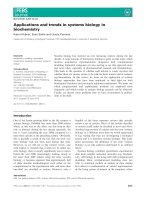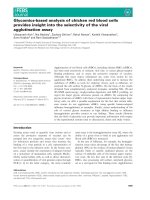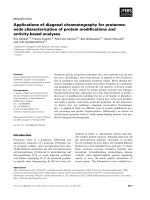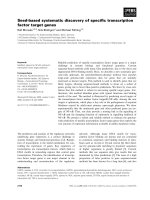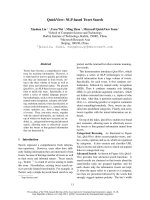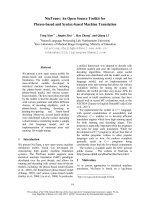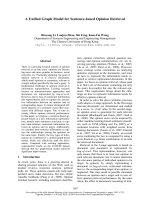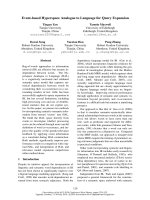Tài liệu Báo cáo khoa học: "ADP based Search Algorithm for Statistical Machine Translation" docx
Bạn đang xem bản rút gọn của tài liệu. Xem và tải ngay bản đầy đủ của tài liệu tại đây (651.98 KB, 8 trang )
A DP based Search Algorithm for Statistical Machine Translation
S. Nieflen, S. Vogel, H. Ney,
and
C. Tillmann
Lehrstuhl fiir Informatik VI
RWTH Aachen - University of Technology
D-52056 Aachen, Germany
Emaih niessen©informatik, rwth-aachen, de
Abstract
We introduce a novel search algorithm for statisti-
cal machine translation based on dynamic program-
ming (DP). During the search process two statis-
tical knowledge sources are combined: a translation
model and a bigram language model. This search al-
gorithm expands hypotheses along the positions of
the target string while guaranteeing progressive cov-
erage of the words in the source string. We present
experimental results on the Verbmobil task.
1 Introduction
In this paper, we address the problem of finding the
most probable target language representation of a
given source language string. In our approach, we
use a DP based search algorithm which sequentially
visits the target string positions while progressively
considering the source string words.
The organization of the paper is as follows. Af-
ter reviewing the statistical approach to machine
translation, we first describe the statistical know-
ledge sources used during the search process. We
then present our DP based search algorithm in de-
tail. Finally, experimental results for a bilingual cor-
pus are reported.
1.1 Statistical Machine Translation
In statistical machine translation, the goal of the
search strategy can be formulated as follows: We
are given a source language ('French') string fl a =
fl • f.t, which is to be translated into a target lan-
guage ('English') string
e~ = el et
with the un-
known length I. Every English string is considered
as a possible translation for the input string. If we
assign a probability
Pr(e~[f()
to each pair of strings
(e/, f~), then we have to choose the length
Iopt
and
-/opt
the English string e 1 that maximize
Pr(e f If J)
for
a given French string fJ. According to Bayes deci-
sion rule,
Iopt
and ~°" can be found by
(Iopt,J1 °"')
=argmax{Pr(e~lf~)}
I,e{
=
argmax{Pr(e().Pr(f~Jlel)}.
(1)
l,e I
Pr(e~) is the English language model, whereas
Pr(flJ[eZa)
is the string translation model.
The overall architecture of the statistical transla-
tion approach is summarized in Fig. 1. In this figure,
we already anticipate the fact that we will transform
the source strings in a certain manner and that we
will countermand these transformations on the pro-
duced output strings. This aspect is explained in
more detail in Section 3.
Source Language
Text
Transformation
1
[ Global Search: -1_ Pr(faIel)
maximize
Pr(el). Pr(f~lel)
over
e I
I
I Transformation
I
1
Target Language
Text
Lexicon Model
I
I o,o.o.,o°., ]
Figure 1: Architecture of the translation approach
based on Bayes' decision rule.
The task of statistical machine translation can be
subdivided into two fields:
1. the field of modelling, which introduces struc-
tures into the probabilistic dependencies and
provides methods for estimating the parameters
of the models from bilingual corpora;
2. the field of decoding, i.e. finding a search algo-
rithm, which performs the argmax operation in
Eq. (1) as efficient as possible.
960
1.2 Alignment with Mixture Distribution
Several papers have discussed the first issue, espe-
cially the problem of word alignments for bilingual
corpora (Brown et al., 1993), (Dagan et al., 1993),
(Kay and RSscheisen, 1993), (Fung and Church,
1994), (Vogel et al., 1996).
In our search procedure, we use a mixture-based
alignment model that slightly differs from the model
introduced as
Model 2
in (Brown et al., 1993). It
is
based on a decomposition of the joint probability for
f~ into a product of the probabilities for each word
d
Pr(flJle~) = p( J[I) " H p(fJl eta),
(2)
3=1
where the lengths of the strings are regarded as
random variables and modelled by the distribution
p(JlI).
Now we assume a sort of pairwise interac-
tion between the French word
fj
and each English
word ei in el i. These dependencies are captured in
the form of a mixture distribution:
I
p(f31ezl) = ~'~p(ilj, J,I) " p(fjlei) •
(3)
i=1
Inserting this into (2), we get
J I
Pr(Y(le~) = p(JII) YI ~~p(ilj, J, i) . p(f~le,)
(4)
j=l i=1
with the following components: the sentence length
probability
p(JlI),
the mixture alignment probabil-
ity
p(ilj, J, I)
and the translation probability
p(fle).
So far, the model allows
all
English words in the
target string to contribute to the translation of a
French word. This is expressed by the sum over i
in Eq. (4). It is reasonable to assume that for each
source string position j one position i in the target
string dominates this sum. This conforms with the
experience, that in most cases a clear word-to-word
correspgndence between a string and its translation
exists. As a consequence, we use the so-called max-
imum approximation: At each point, only the
best
choice of i is considered for the alignment path:
d
Pr(/( le~)
=p( JII) ~I m~ p(ilj, J, I).p(fj]e~).
(5)
j=l "el, ]
We can now formulate the criterion to be maximized
by a search algorithm:
max [p( JlI) max { Pr(e[).
I el
H m.ax ~(ilj, J,I )
.p(f31e~)l
.
j=l ie[1,1]
(6)
Because of the problem of data sparseness, we use
a parametric model for the alignment probabilities.
It assumes that the distance of the positions relative
to the diagonal of the (j, i) plane is the dominating
factor:
r(i _j I)
p(ilj,
J, I) = (7)
,
Ei,=l r(i' - j )
As described in (Brown et al., 1993), the EM al-
gorithm can be used to estimate the parameters of
the model.
1.3 Search in Statistical Machine
Translation
In the last few years, there has been a number of
papers considering the problem of finding an effi-
cient search procedure (Wu, 1996), (Tillmann et al.,
1997a), (TiUmann et al., 1997b), (Wang and Waibel,
1997). All of these approaches use a bigram language
model, because they are quite simple and easy-to-
use and they have proven their prediction power
in stochastic language processing, especially speech
recognition. Assuming a bigram language model, we
would like to re-formulate Eq. (6) in the following
way:
J
max[p(J]I)m~axljX~l max~(eilei-1)'l
e 1 .= iE[1,I]
P(ilJ, J,I)'p(fjlei)] }] •
(8)
Any search algorithm tending to perform the max-
imum operations in Eq. (8) has to guarantee, that
the predecessor word ei-1 can be determined at the
time when a certain word
ei
at position i in the tar-
get string is under consideration. Different solutions
to this problem have been studied.
(Tillmann et al., 1997b) and (Tillmann et al.,
1997a) propose a search procedure based on dynamic
programming, that examines the source string se-
quentially. Although it is very efficient in terms
of translation speed, it suffers from the drawback
of being dependent on the so-called monotonicity
constraint: The alignment paths are assumed to
be monotone. Hence, the word at position i - 1
in the target sentence can be determined when the
algorithm produces
ei.
This approximation corre-
sponds to the assumption of the fundamental simi-
laxity of the sentence structures in both languages.
In (Tillmann et al., 1997b) text transformations in
the source language are used to adapt the word or-
dering in the source strings to the target language
grammar.
(Wang and Waibel, 1997) describe an algorithm
based on A*-search. Here, hypotheses are extended
961
by adding a word to the end of the target string
while considering the source string words in any or-
der. The underlying translation model is
Model 2
from (Brown et al., 1993).
(Wu, 1996) formulates a DP search for stochastic
bracketing transduction grammars. The bigram lan-
guage model is integrated into the algorithm at the
point, where two partial parse trees are combined.
2 DP Search
2.1 The Inverted Alignment Model
For our search method, we chose an algorithm which
is based on dynamic programming. Compared to an
A'-based algorithm dynamic programming has the
fundamental advantage, that solutions of subprob-
lems are stored and can then be re-used in later
stages of the search process. However, for the op-
timization criterion considered here dynamic pro-
gramming is only suboptimal because the decompo-
sition into independent subproblems is only approx-
imately possible: to prevent the search time of a
search algorithm from increasing exponentially with
the string lengths and vocabulary sizes, local deci-
sions have to be made at an earlier stage of the opti-
mization process that might turn out to be subopti-
mal in a later stage but cannot be altered then. As
a consequence, the global optimum might be missed
in some cases.
The search algorithm we present here combines
the advantages of dynamic programming with the
search organization along the positions of the target
string, which allows the integration of the bigram in
a very natural way without restricting the alignment
paths to the class of monotone alignments.
The alignment model as described above is defined
as a function that assigns exactly one target word to
each source word. We introduce a new interpretation
of the alignment model: Each position i in e / is
assigned a position
bi = j
in fl J. Fig. 2 illustrates
the possible transitions in this inverted model.
At each position i of el, each word of the target
language vocabulary can be inserted. In addition,
the
fertility l
must be chosen: A position i and the
word
ei
at this position are considered to correspond
to a sequence of words
f~:+1-t
in f]. In most cases,
the optimal fertility is 1. It is also possible, that a
word
ei
has fertility 0, which means that there is no
directly corresponding word in the source string. We
call this a
skip,
because the position i is skipped in
the alignment path.
Using a bigram language model, Eq. (9) specifies
the modified search criterion for our algorithm. Here
as above, we assume the maximum approximation to
be valid.
°~
e~
L,.
.~
0
.N
O
: : _. •
: _" : :
c~ ~ ~
position in source string
Figure 2: Transitions in the inverted model.
I
max[p(dlI)ma:xH[p(eiJei-1)"
I el i=1
' J
max 1"I
{P(ilJ'J'I)'P(:31ei)}
j,t_
l=j-l+l
(9)
For better legibility, we regard the second product
in Eq. (9) to be equal to 1, ifl = 0. It should be
stressed that the pair (I,e{) optimizing Eq. (9) is
not guaranteed to be also optimal in terms of the
original criterion (6).
2.2 Basic Problem: Position Coverage
.4. closer look at Eq. (9) reveals the most important
problem of the search organization along the target
string positions: It is not guaranteed, that all the
words in the source string are considered. In other
words we have to force the algorithm to cover all
input string positions. Different strategies to solve
this problem are possible: For example, we can in-
troduce a reward for covering a position, which has
not yet been covered. Or a penalty can be imposed
for each position without correspondence in the tar-
get string.
In preliminary experiments, we found that the
most promising method to satisfy the position cov-
erage constraint is the introduction of an additional
parameter into the recursion formula for DP. In the
following, we will explain this method in detail.
2.3 Recursion
Formula for
DP
In the DP formalism, the search process is described
recursively. Assuming a total length I of the target
string,
Q1(c, i, j, e)
is the probability of the best par-
tial path ending in the coordinates i in el / and j in
f J, if the last word ei is e and if c positions in the
source string have been covered.
962
This quantity is defined recursively. Leaving a
word ei without any assignment
(skip)
is the easiest
case:
QS (c, i, j, e) = max {p(ele')Q1(c, i - 1, j,
d)} .
Note that it is not necessary to maximize over the
predecessor positions jr: This maximization is sub-
sumed by the maximization over the positions on the
next level, as can easily be proved.
In the original criterion (6), each position j in the
source string is aligned to exactly one target string
position i. Hence, if i is assigned to I subsequent po-
sitions in fl s, we want to verify that none of these po-
sitions has already been covered: We define a control
function v which returns 1 if the above constraint is
satisfied and 0 otherwise. Then we can write:
fH
Qr](c,i.j,e) = max {p(il3, J,I )
• p(f3iei)} •
• l>0 " ~=j l+l
max
{p(eie')"
e j
mjax [Q,(c- l,i - 1,f ,e') .v(c,l,f ,j,e')] )] ,
We now have to find the maximum:
Q,(c, i, j, e) = max {QS(c, i, j, e), Qn(c, i, j, e)} .
The decisions made during the dynamic program-
ming process (choices of l, j' and e ~) are stored for
recovering the whole translation hypothesis.
The best translation hypothesis can be found by
optimizing the target string length I and requiring
the number of covered positions to be equal to the
source string length J:
max {P(JlI) " maxQ1(J'I'j'e) } j,e
(10)
2.4 Acceleration Techniques
The time comple.,dty of the translation method as
described above is
O(i2ax " j3 .
iSl 2)
,
where I~] is the size of the target language vocab-
ulary C. Some refinements of this algorithm have
been implemented to increase the translation speed.
1. We can expect the progression of the source
string coverage to be roughly proportional to
the progression of the translation procedure
along the target string. So it is legitimate to
define a minimal and maximal coverage for each
level i:
Cmin(i)= [iJJ -r, Cmax(i)= [i~] + r ,
where r is a constant integer number. In prelim-
inary experiments we found that we could set r
to 3 without any loss in translation accuracy.
This reduces the time complexity by a factor J.
2. Optimizing the target string length as formu-
lated in Eq. (10) requires the dynamic program-
ming procedure to start all over again for each
I. If we assume the dependence of the align-
ment probabilities
p(ilj, J, I)
on I to be negligi-
ble, we can renormalize them by using an esti-
mated target string length/~ and use
p(ilj , J, I).
Now we can produce one translation e~ at each
level i = I without restarting the whole process:
max Vi(J, I, j, e) .
(11)
3,e
For/~ we choose: /~ = ](J) = J-/~- where p¢
and #j denote the average lengths of the target
and source strings, respectively.
This approximation is partly undone by what
we call
rescoring:
For each translation hypoth-
esis e / with length I, we compute the "true"
score (~(I) by searching the best inverted align-
ment given e / and fs and evaluating the prob-
abilities along this alignment. Hence, we finally
find the best translation via Eq. (12):
max{,(JII) (12)
The time complexity for this additional step is
negligible, since there is no optimization over
the English words, which is the dominant factor
in the overall time complexity
O(Imax " j2 .
[E.[2) .
3. We introduced two thresholds:
SL" If e' is the predecessor word of e and e is
not aligned to the source string ("skip"),
then
p(eie')
must be higher than SL.
ST" A word e can only be associated with a
source language word f, if
p(f[e)
is higher
than ST.
This restricts the optimization over the target
language vocabulary to a relatively small set of
candidate words. The resulting time complexity
is
O(Im~x. J2-IEI).
4. When searching for the best partial path to a
gridpoint
G = (c,i,j,e),
we can sort the arcs
leading to G in a specific manner that allows us
to stop the computation whenever it becomes
clear that no better partial path to G exists.
The effect of this measure depends on the qual-
ity of the used models; in preliminary experi-
ments we observed a speed-up factor of about
3.5.
963
3 Experiments
The search algorithm suggested in this paper was
tested on the Verbmobil Corpus. The results of pre-
liminary tests on a small automatically generated
Corpus (Amengual et al., 1996) were quite promis-
ing and encouraged us to apply our search algorithm
to a more realistic task.
The Verbmobil Corpus consists of spontaneously
spoken dialogs in the domain of appointment sche-
duling (Wahlster, 1993). German source sentences
are translated into English. In Table 1 the character-
istics of the training and test sets are summarized.
The vocabularies include category labels for dates,
proper names, numbers, times, names of places and
spellings. The model parameters were trained on
16 296 sentence pairs, where names etc. had been
replaced by the appropriate labels.
Table 1: Training and test conditions of the Verb-
mobil task.
formed sample translations (i.e. after labelling) was
13.8.
In preliminary evaluations, optimal values for the
thresholds
OL
and
OT
had been determined and kept
fixed during the experiments.
As an automatic and easy-to-use measure of the
translation performance, the Levenshtein distance
between the produced translations and the sample
translations was calculated. The translation results
are summarized in Table 2.
Table 2: Word error rates on the Verbmobil Corpus:
insertions (INS), deletions (DEL) and total rate
of word errors (WER) before (BL) and after (AL)
rule-based translation of the labels.
before / after
Error Rates (%)
INS DEL WER
BL 7.3 18.4 45.0
AL 7.6 17.3 39.6
Words in Vocabulary
German 4 498
English 2 958
Number of Sentences
in Training Corpus 16 296
in Test Corpus 150
Given the vocabulary sizes, it becomes quite ob-
vious that the lexicon probabilities
p(f[e)
can not
be trained sufficiently on only 16 296 sentence pairs.
The fact that about 40% of the words in the lexicon
are seen only once in training illustrates this. To im-
prove the lexicon probabilities, we interpolated them
with lexicon probabilities
pM(fle)
manually created
from a German-English dictionary:
{'o
~ if
(e, f)
is in the dictionary
pM(fle)
_ otherwise '
where Ne is the number of German words listed as
translations of the English word e. The two lexica
were combined by linear interpolation with the in-
terpolation parameter A. For our first experiments,
we set A to 0.5.
The test corpus consisted of 150 sentences, for
which sample translations exist. The labels were
translated separately: First, the test sentences were
preprocessed in order to replace words or groups
of words by the correct category label. Then, our
search algorithm translated the transformed sen-
tences. In the last step, a simple rule-based algo-
rithm replaced the category labels by the transla-
tions of the original words.
We used a bigram language model for the Eng-
lish language. Its perplexity on the corpus of trans-
(Tillmann et al., 1997a) report a word error rate
of 51.8% on similar data.
Although the Levenshtein distance has the great
advantage to be automatically computable, we have
to keep in mind, that it depends fundamentally on
the choice of the sample translation. For example,
each of the expressions "thanks", "thank you" and
"thank you very much" is a legitimate translation
of the German "danke schSn", but when calculating
the Levenshtein distance to a sample translation, at
least two of them will produce word errors. The
more words the vocabulary contains, the more im-
portant will be the problem of synonyms.
This is why we also asked five experts to classify
independently the produced translations into three
categories, being the same as in (Wang and Waibel,
1997):
Correct translations
are grammatical and convey
the same meaning as the input.
Acceptable translations
convey the same meaning
but with small grammatical mistakes or they convey
most but not the entire meaning of the input.
Incorrect translations
are ungrammatical or con-
vey little meaningful information or the information
is different from the input.
Examples for each category are given in Table
3. Table 4 shows the statistics of the translation
performance. When different judgements existed
for one sentence, the majority vote was accepted.
For the calculation of the subjective sentence error
rate (SSER), translations from the second category
counted as "half-correct".
When evaluating the performance of a statistical
machine translator, we would like to distinguish er-
rors due to the weakness of the underlying models
964
Table 3: Examples of Correct (C), Acceptable (A), and Incorrect (I) translations on Verbmobil. The source
language is German and the target language is English.
C
Input:
Output:
Input:
Output:
Ah neunter M/irz bin ich in KSln.
I am in Cologne on the ninth of March.
Habe ich mir notiert.
I have noted that.
A
Input:
Output:
Input:
Output:
Samstag und Februar sind gut, aber der siebzehnte w~ire besser.
Saturday and February are quite but better the seventeenth.
Ich kSnnte erst eigentlich jetzt wieder dann November vorschlagen. Ab zweiten
November.
I could actually coming back November then. Suggest beginning the second of November.
Input:
Output:
Ja, also mit Dienstag und mittwochs und so h/itte ich Zeit, aber Montag kommen wir
hier nicht weg aus Kiel.
Yes, and including on Tuesday and Wednesday as well, I have time on Monday but we
will come to be away from Kiel.
Input: Dann fahren wir da los.
Output: We go out.
Table 4: Subjective evaluation of the translation
performance on Verbmobil: number of sentences
evaluated as Correct (C), Acceptable (A) or In-
correct (I). For the total percentage of non-correct
translations (SSER), the "acceptable" translations
are counted as half-errors.
I Total Correct Acceptable Incorrect SSER I
150 61 45 44 44.3%
from
search errors,
occuring whenever the search
algorithm misses a translation hypothesis with a
higher score. Unfortunately, we can never be sure
that a search error
does not occur,
because we do
not know whether or not there is another string with
an even higher score than the produced output.
Nevertheless, it is quite interesting to compare the
score of the algorithm's output and the score of the
sample translation in such cases in which the out-
put is not correct (it is classified as "acceptable" or
"incorrect" ).
The original value to be maximized by the search
algorithm (see Eq. (6)) is the score as defined by the
underlying models and described by Eq. (13).
J
Pr(e~).p(JII) H max ~(ilj , J, I). p(fjlei)] •
(13)
j=l ie[1,1]
We calculated this score for the sample trans-
lations as well as for the automatically generated
translations. Table 5 shows the result of the com-
parison. In most cases, the incorrect outputs have
higher scores than the sample translations, which
leads to the conclusion that the improvement of the
models (stronger language model for the target lan-
guage, better translation model and especially more
training data) will have a strong impact on the qual-
ity of the produced translations. The other cases, i.
e. those in which the models prefer the sample trans-
lations to the produced output, might be due to the
difference of the original search criterion (6) and the
criterion (9), which is the basis of our search algo-
rithm. The approximation made by the introduction
of the parameters
OT
and
OL
is an additional reason
for search errors.
Table 5: Comparison: Score of Reference Transla-
tion e and Translator Output e ~ for "acceptable"
translations (A) and "incorrect" translations (I).
For the total number of non-correct translations
(T), the "acceptable" translations are counted as
half-errors.
A I T %
Total number 45 44 66.5 100.0
Score(e) >_ Score(C)
11 13 18.5 27.8
Score(e) < Score(C)
34 31 48.0 72.2
As far as we know, only two recent papers have
dealt with decoding problem for machine translation
systems that use translation models based on hid-
den alignments without a monotonicity constraint:
(Berger et al., !994) and (Wang and Waibel, 1997).
The former uses data sets that differ significantly
from the Verbmobil task and hence, the reported
results cannot be compared to ours. The latter
presents experiments carried out on a corpus corn-
965
parable to our test data in terms of vocabulary sizes,
domain and number of test sentences. The authors
report a subjective sentence error rate which is in
the same range as ours. An exact comparison is
only possible if exactly the same training and test-
ing data are used and if all the details of the search
algorithms are considered.
4 Conclusion and Future Work
In this paper, we have presented a new search al-
gorithm for statistical machine translation. First
experiments prove its applicability to realistic and
complex tasks such as spontaneously spoken dialogs.
Several improvements to our algorithm are plan-
ned, the most important one being the implementa-
tion of pruning methods (Ney et al., 1992). Pruning
methods have already been used successfully in ma-
chine translation (Tillmann et al., 1997a). The first
question to be answered in this context is how to
make two different hypotheses H1 and/-/2 compara-
ble: Even if they cover the same number of source
string words, they might cover different words, es-
pecially words that are not equally difficult to trans-
late, which corresponds to higher or lower transla-
tion probability estimates. To cope with this prob-
lem, we will introduce a heuristic for the estimation
of the cost of translating the remaining source words.
This is similar to the heuristics in A'-search.
(Vogel et al., 1996) report better perplexity re-
sults on the Verbmobil Corpus with their HMM-
based alignment model in comparison to Model 2
of (Brown et al., 1993). For such a model, however,
the new interpretation of the alignments becomes
essential: We cannot adopt the estimates for the
alignment probabilities p(ili', I). Instead, we have
to re-calculate them as inverted alignments. This
will provide estimates for the probabilities P(JlJ', J).
The most important advantage of the HMM-based
alignment models for our approach is the fact, that
they do not depend on the unknown target string
length I.
Acknowledgement. This work was partly sup-
ported by the German Federal Ministry of Educa-
tion, Science, Research and Technology under the
Contract Number 01 IV 601 A (Verbmobil).
References
J. C. Amengual, J. M. Benedi, A. Castafio, A. Mar-
zal, F. Prat, E. Vidal, J. M. Vilar, C. Delogu,
A. di Carlo, H. Ney, and S. Vogel. 1996. Example-
Based Understanding and Translation Systems
(EuTrans): Final Report, Part I. Deliverable of
ESPRIT project No. 20268, October.
A.L. Berger, P.F. Brown, J. Cocke, S.A. Della
Pietra, V.J. Della Pietra, J.R. Gillett, J.D. Laf-
ferty, R.L. Mercer, H. Printz, and L. Ures. 1994.
The Candide System for Machine Translation. In
Proc. ARPA Human Language Technology Work-
shop, Plainsboro, N J, pages 152-157. Morgan
Kanfmann Publ., March.
P.F. Brown, S.A. Della Pietra, V.J. Della Pietra,
and R.L. Mercer. 1993. Mathematics of Statisti-
cal Machine Translation: Parameter Estimation.
Computational Linguistics, 19(2):263-311.
I. Dagan, K. W. Church, and W. A. Gale. 1993.
Robust Bilingual Word Alignment for Machine
Aided Translation. In Proceedings of the Work-
shop on Very Large Corpora, Columbus, Ohio,
pages 1-8.
P. Fung and K.W. Church. 1994. K-vet: A new Ap-
proach for Aligning Parallel Texts. In Proceedings
of the 15th International Conference on Compu-
tational Linguistics, Kyoto, Japan, pages 1096-
1102.
M. Kay and M. RSscheisen. 1993. Text-Trans-
lation Alignment. Computational Linguistics,
19(1):121-142.
H. Ney, D. Mergel, A. Noll, and A. Paeseler. 1992.
Data Driven Search Organization for Continuous
Speech Recognition. IEEE Transactions on Sig-
nal Processing, 40(2):272-281, February.
C. Tillmann, S. Vogel, H. Ney, H. Sawaf, and A. Zu-
biaga. 1997a. Accelerated DP based Search for
Statistical Translation. In Proceedings of the 5th
European Conference on Speech Communication
and Technology, Rhodes, Greece, pages 2667-2670,
September.
C. Tillmann, S. Vogel, H. Ney, and A. Zubia-
ga. 1997b. A DP-Based Search using Monotone
Alignments in Statistical Translation. In Proceed-
ings of the ACL/EACL '97, Madrid, Spain, pages
289-296, July.
S. Vogel, H. Ney, and C. Tillmann. 1996. HMM-
Based Word Alignment in Statistical Translation.
In Proceedings of the 16th International Confer-
ence on Computational Linguistics, Copenhagen,
Denmark, pages 836-841, August.
W. Wahlster. 1993. Verbmobih Translation of Face-
to-Face Dialogs. In Proceedings of the MT Sum-
mit IV, pages 127-135, Kobe, Japan.
Ye-Yi Wang and A. Waibel. 1997. Decoding Algo-
rithm in Statistical Translation. In Proceedings of
the ACL/EACL '97, Madrid, Spain, pages 366-
372, July.
D. Wu. 1996. A Polynomial-Time Algorithm for
Statistical Machine Translation. In Proceedings
of the 34th Annual Conference of the Association
for Computational Linguistics, Santa Cruz, CA,
pages 152 - 158, June.
966
Zusammenfassung
Wir stellen einen neuartigen Suchalgorithmus flit
die statistische maschinelle Ubersetzung vor, der
auf der dynamischen Programmierung (DP) beruht.
W~ihrend des Suchprozesses werden.zwei statistische
Wissensquellen kombiniert: Ein Ubersetzungsmo-
dell und ein Bigramm-Sprachmodell. Dieser Such-
algorithmus erweitert Hypothesen entlang den Posi-
tionen des Zielsatzes, wobei garantiert wird, dab alle
WSrter im Quellsatz berficksichtigt werden. Es wer-
den experimentelle Ergebnisse auf der Verbmobil-
Aufgabe angegeben.
Rdsumd
Nous prdsentons un nouveau algorithme de recherche
pour la traduction automatiquestatistique qui est
basde sur la programmation dynamique (DP). Pen-
dant la recherche deux sources d'information statis-
tiques sont combindes: Un module de traduction
et un bigram language model. Cet algorithme de
recherche construit des hypotheses le long des po-
sitions de la phrase en langue de cible tout en
garantissant la considdration progressive des mots
dans la phrase en langue de source. Des rdsultats
expdrimentaux sur la t~che Verbmobil sont prdsen-
tds.
967
